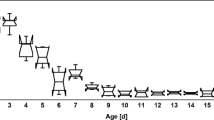Abstract
Honey bees have a highly developed nest homeostasis, for example, maintaining low CO2 levels and stable nest temperatures at 35°C.We investigate the role of nest homeostasis in deactivating phenolic compounds present in the nectar of Aloe littoralis. We show that the phenolic content in nectar was reduced (from 0.65% to 0.49%) after nectar was incubated in a nest of Apis cerana, and that it was reduced still more (from 0.65% to 0.37%) if nectar was mixed with hypopharyngeal gland proteins (HGP) of worker bees before being placed inside a nest. HGP had little effect on samples outside a nest, indicating that nest conditions are necessary for HGP to deactivate phenolics in nectar. Consequently, the highly controlled nest homeostasis of honey bees facilitates direct deactivation of phenolics in nectar, and plays a role in the action of HGP as well.

Similar content being viewed by others
References
Adler LS (2000) The ecological significance of toxic nectar. Oikos 91:409–420
Baker HG (1977) No-sugar chemical constituents of nectar. Apidologie 8:349–356
Bradford M (1976) A rapid and sensitive method for the quantification of microgram quantities of proteins utilizing the principle of protein-dye binding. J Anal Biochem 72:248–254
Detzel A, Wink M (1993) Attraction, deterrence or intoxication of bees (Apis mellifera) by plant allelochemicals. Chemoecology 4:8–18
Faegri K, van der Pijl L (1979) The principles of pollination ecology, 3rd revised edn. Pergamon Press, Oxford
Haglar JR, Buchmann SL (1993) Honey bee (Hymenoptera: Apidae) foraging responses to phenolic-rich nectar J Kansas Entomol Soc 66:223–230
Kubo T, Sasaki M, Nakamura J, Sasagawa H, Ohashi K, Takeuchi H, Natori S (1996) Change in the expression of hypopharyngeal-gland proteins of the worker honeybees (Apis mellifera L.) with age and/or role. J Biochem 119:291–295
Musser RO, Hum-Musser SM, Eichenseer H, Peiffer M, Ervin G, Murphy JB, Felton GW (2002) Caterpillar saliva beats plant defences Nature 416:599–600
Ohashi K, Natori S, Kubo T (1999) Expression of amylase and glucose oxidase in the hypopharyngeal gland with an age-dependent role change of the worker honeybee (Apis mellifera L.). Eur J Biochem 265:127–133
Rhoades DF, Bergdahl JC (1981) Adaptive significance of toxic nectar. Am Nat 117:798–803
Shi B, Di Y (2000) Plant polyphenols. Academic Press, Beijing
Winston ML (1987) The biology of the honey bee Princeton University Press, Princeton
Xu WL (1983) Bee plants in China. Helongjiang Science Press, Ha’erbing
Acknowledgement
We thank Prof. Xiangxiong Zhu, Shanghai Institutes for Biological Sciences, the Chinese Academy of Sciences and Adjunct Prof. Michael D. Breed, University of Colorado at Boulder and Xishuangbanna Tropical Botanic Garden, the Chinese Academy of Sciences for English improvement. We are especially grateful to two anonymous reviewers for their valuable comments and substantial contributions to improve the presentation. This work is supported by a grant of the National Natural Science Foundation of China (award number: 39930030)
Author information
Authors and Affiliations
Corresponding author
Rights and permissions
About this article
Cite this article
Liu, F., He, J. & Fu, W. Highly controlled nest homeostasis of honey bees helps deactivate phenolics in nectar. Naturwissenschaften 92, 297–299 (2005). https://doi.org/10.1007/s00114-005-0629-x
Received:
Accepted:
Published:
Issue Date:
DOI: https://doi.org/10.1007/s00114-005-0629-x




